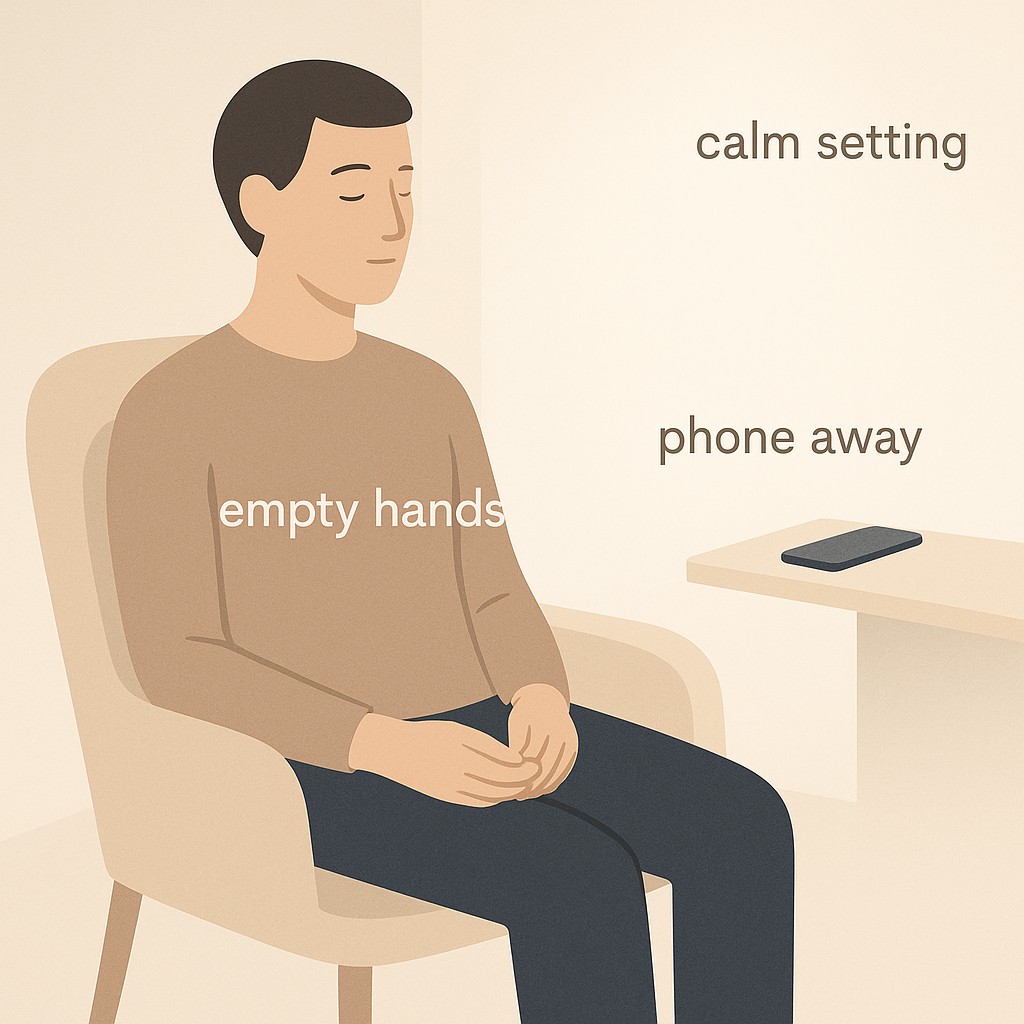Improve Focus with Stillness: The Hidden Engine of Productivity
Improve Focus with Stillness: The Hidden Engine of Productivity

Stillness as the Hidden Engine of Productivity
Doing nothing might be the most productive thing you do today. I know, that sounds backwards. It really does—especially if your calendar is wall-to-wall with meetings, build scripts, and a dozen Slack threads stacking up.
Meditation always felt out of reach for me. There was this pressure to ‘clear my mind’ perfectly, and honestly, it quickly became just another thing I failed to do “right.” Six months ago, I would have laughed if someone suggested just sitting in silence. But recently, I tried something way simpler: no apps, no mantras. Just sitting still to improve focus with stillness—no phone within arm’s reach.
Here’s how I ran my first experiment. I told myself: 15 minutes, alone in a quiet room. I actually left my phone in the other room (the urge to check it was so strong it’s a little embarrassing to admit). No music, no “productive” background podcast, no checking email “just one last time.” The only rule was to stay put and let whatever happened, happen—no chasing a blank mind or worrying about whether it would “work.” I set a timer, which felt almost like cheating, but at least stopped me from constantly checking the clock. I was expecting boredom, maybe even frustration.

At first, my mind raced with deadlines, architecture issues, and those “what ifs” that creep in when you finally log off. It was distracting—honestly, pretty uncomfortable.
But after a few minutes, something shifted. Slowly, the noise settled. No sudden breakthrough, but the mental background got less chaotic. Things I’d been looping on started to sort themselves out. Priorities surfaced almost on their own, kind of like that bug you finally understand after taking a break for lunch. It reminded me of those rare, in-the-zone engineering moments—flow isn’t just for coding. I was starting to feel it here, too.
By the end, I felt grounded. Less reactive. I could feel my focus improving with stillness. It wasn’t magic, but the effect was real. Stick around—I’ll show you a quick three-step reset that can actually sharpen decision-making and feed your best ideas.
Why Doing Nothing Actually Works: The Engineering Behind Stillness
What surprised me most about that first 15-minute trial was how much clarity showed up—even though it looked nothing like formal meditation. No crossed legs, no mystical soundtrack. Just stillness. And somehow, it worked. My thinking got a little less tangled, and the sense of urgency faded. Turns out, you don’t need perfect technique or years of mindfulness experience to get this effect. For me, it worked right away—because I finally gave my brain a short, structured break from inputs.
So I started comparing it to a CPU scheduler. Before I came to meditation, I spent way too much time staring at perf logs and worrying about stack traces, so this felt familiar. Your brain, like a server, needs to reduce cognitive load caused by constant context-switching—Slack, Jira, IDE, then back again. Every mental switch leaves something behind, cluttering your “RAM.” That’s what researchers call attention residue—when some of your focus lingers on your last task instead of shifting cleanly to the present. Stillness—just 15 device-free minutes—is a kind of garbage collection. By pushing pause for actual quiet (not audiobook-and-chill), you give your mind time to clear interference and improve recall. The reset lets real priorities bubble up, not buried under leftover noise.
But productivity starts with presence. Before you can produce real results, you need to know when to reset, so your focus gets a full reboot.
If you’ve heard that only “pure” meditation matters, just forget it. Purposeful inactivity—just sitting without aiming for zen perfection—is not wasted time. It’s part of the work, like killing background processes so your main app actually runs. If you can sit still for 15 minutes, you can get this benefit. No special skills or rituals required.
Engineering work is full of decision fatigue and a constant pull toward deep work, which is exactly why stillness for engineers matters. This is how you reclaim your edge. With a calmer, clearer mind, every technical judgment and creative leap gets sharper. Try it tomorrow morning—your next big solution might need space, not speed.
Improve Focus With Stillness: Turn It Into Repeatable Focus
If you want this to work, don’t just promise yourself “quiet time” someday. Slot it in as an attention reset routine exactly when your mind is messy—right before deep work or a big design decision. That’s when your head is full of possibilities, problems, and scattered plans. Pause on purpose. Give yourself those 15 minutes (a calendar reminder never hurts) and say, “This time is for clearing the board. Attention resets now.” You’re not chasing zen—you’re just creating room for things to settle.
Here’s the actual setup. Make it so simple it feels almost silly: find a quiet spot, actually block it off on your calendar to time-block guilt-free focus, and put your phone somewhere you can’t reach intentionally. No music, no notifications, no “just checking Slack while I sit.” The only input is your own thoughts—don’t sabotage it with apps, even the ones that promise to “help.” Give your brain real downtime, not a swap to another input.
The first five minutes will probably be rough. Your mind jumps all over the place: backlog bugs, unread emails, that architecture question that’s still unresolved. You’ll want to check your phone. Just sit with it. Around minute seven—sometimes earlier, sometimes later—things usually start to slow down. Thoughts untangle.
Here’s the payoff: stray worries settle, real priorities show up, sometimes even an idea that wasn’t on your radar before. I usually keep a tiny scrap of paper nearby. Once, I used a grocery receipt instead because I’d lost my notebook. Anyway, if something surfaces and feels important, jot it down. Not everything is gold—sometimes it’s just “refactor that test suite”—but sometimes, it’s exactly the clarity you needed to get unstuck. Even if it feels obvious, write it down. By the end, the mental clutter thins out, and you’re not just reacting—you’re choosing what to do next. That single capture step saves me on overload days.
Try this template: write your top one to three priorities for today and one idea you want to test. That’s it. Anchor the post-stillness clarity to something actionable. No complex system; just make stillness productive, not theoretical.
If you keep at this, it stops feeling like an experiment and starts feeling like real leverage. Pick a trigger—before your standup, right before a design review—and run it daily for a week. Consider it a low-tech experiment: see what changes, jot what you notice, repeat. It felt pointless at first for me, and that’s fine. But after a week, the sharper focus started showing up where it counted.
It’s Normal to Question Stillness—Here’s Why It’s Worth It
If you’re thinking, “I can’t afford 15 minutes of doing nothing,” you’re in good company. That was exactly my worry, too. There’s always another diff to review or pipeline to unblock. But here’s what flipped my script: the longer you allow yourself to embrace productive downtime for engineers—even just 15 minutes—the bigger the performance bounce when you’re back. Simple math here: letting your brain clear the mental logjam up front means choices improve and your time gets a bit cleaner afterward. A tiny investment, dividends all day—especially when every minute counts.
Sometimes the best clarity sneaks up on you during random idle moments. Like, last week, I found myself zoning out while watching a duck waddle past the parking lot at work. For some reason, it got me thinking about edge cases in a model, and the answer I needed dropped in. Still not sure why, but it worked. Mind idling isn’t always wasted time.
Honestly, it does feel weird at first. Sitting there without a “task,” I got twitchy, even guilty. But it’s not a bug—it’s transition pain, not a sign you’re broken. Science backs this up: real downtime lets your nervous system reset, pulling you from reactive mode into a steady baseline. If you build under deadline or pressure, that reset flips the switch from scramble to clarity, and it’s a good moment to run a quick burnout check. If your brain gets “busy” or restless, you’re not failing; it’s just normal. The arrival at calm is worth the discomfort upfront.
And about perfection—don’t fall for it. I still haven’t figured out how to get a silent, blank mind. I just settle for less chaos. Remember that first stillness block I mentioned earlier? My thoughts were a mess; the fact that I didn’t bail out was a win. You can show up imperfectly and get the benefits, even if you’re all over the place for most of it. There’s no grading scale. If you try, presence and focus follow, messy process or not.
Turn clear ideas into publishable posts fast with our app, which generates AI-powered drafts, blog posts, and LinkedIn updates tailored to engineers, so you can ship content without getting bogged down.
Real-World Use Cases: When Stillness Actually Changes the Game
If you build, review, or lead, you know how “busy” becomes default. And how quickly hard decisions stack up. That’s why stillness breaks for developers are perfect right before heavy-lift moments: system architecture breakdowns, sketching a model, code reviews, or staring down a gnarly prod incident. In practice, it’s just stepping away from screens—no phone, just a wall or window—and letting the mental swirl settle down. More than once, a nagging design knot untangled on its own from the earlier chaos. Other times, the day’s top priorities quietly arrange themselves by the finish.
My only “tool” is a scrap of paper. If something critical surfaces, jot it, then get moving. It’s not about zen; it’s brain defrag before decisions—makes smarter engineering judgment so much easier.
The move is this: put one 15-minute block on your calendar, for today. Not next week. Place it before your next technical decision and have something to note what comes up. Try it—see how your focus actually feels once you’re done, not just how it looks on paper.
And I guess that’s the trick: sometimes, doing nothing is exactly what lets you choose the next move that matters.
Enjoyed this post? For more insights on engineering leadership, mindful productivity, and navigating the modern workday, follow me on LinkedIn to stay inspired and join the conversation.
You can also view and comment on the original post here .
